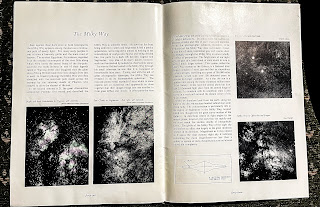The author was listed as one Dr Henry C King of the London Planetarium, so it was always going to be a book with a more astronomical bent than I would have preferred, but even so the information inside was of a very high quality.
Large full page spreads were devoted to clear and detailed images of the moons phases, with excellent resolution on the near side, showing the rilles and craters. The acknowledgements in the foreword indicate that these were taken with the American Lick and Mount Palomar telescope observatories and are of stunning quality.
As the volume is dated 1966, it sits at the crucial period of lunar exploration, when both the US and Russia were still gripped in the race for the moon and we’re desperate to map the surface in advance of a landing.
The only photograph of the far side is provided by the Soviet Lunik III probe which flew past the moon in 1959, showing the hidden far side for the first time. the book also includes shots from the American Ranger series probes - 7 and 8 and a large photograph of the first Surveyor soft landing probe, which was due to launch the year the book was published and a model of the projected Lunar Orbiter satellite, which would be instrumental in the selection of the future landing site of the Apollo mission, just four years later.
It rounds out the chapter with an early painting of the projected Apollo Command Module and LEM showing a long legged version of the landing craft, which was under development at the time. All in all it is a nice little book, with some excellent information and one or two simple line drawings. The smaller ‘pocket size’ of the book makes it quite attractive too.
Some time earlier, I had picked up a souvenir booklet from the London Planetarium - its undated but seems to be from shortly after the building was opened, in 1958. It’s a slim volume, with lots of information about the Zeiss projector installed in the new building, which was at the time cutting edge and only one of five to leave the German factories, for export.
The director of the Planetarium was our friend Dr King, who was writer of the previous book and the souvenir has a brief biography of him.
The director of the Planetarium was our friend Dr King, who was writer of the previous book and the souvenir has a brief biography of him.
Once more the booklet is full of beautiful black and white photographs of astronomical phenomena, such as star and galaxies - which are again credited to the Lick and Palomar Observatories.

The images of the gas giants and inner planets, however are still quite indistinct and a long way from the material which would be provided by modern probes, some forty years later.
The spread on the moon is very reminiscent of Dr Kings book, showing a large photograph of the lunar disk. It’s apparent that this spread has a distinct yellow discolouration on the pages, as when it arrived, I found it held a newspaper clipping for the Daily Telegraph, from 1958 with a lunar globe on it, still pressed between the pages.
The illustration has all the major surface features listed and the brief text accompanying the illustration indicates the first probe to be sent to the Moon was on the launch pad, atop a Thor Able rocket.
This would appear to refer to ‘Pioneer 0’ or Able 1 as it was officially designated and was the US Air Force's first attempt to launch a probe to the Moon. The launch failed, as the rocket exploded 9 miles into its journey. It marked the beginning of the series of deep space probe launches and predated the formation of NASA and was humanity’s first attempt at sending a spacecraft beyond the orbit of Earth.




















